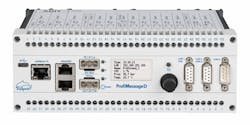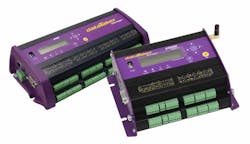A data logger is a type of data acquisition system, but a data acquisition system is not necessarily a data logger. There are several key functional differences between these two classes of instruments. While the differences have been reduced as the technology has advanced, there are still features that separate them.
Sample and conversion rates
The instrumentation market understands a data logger to be a relatively slow sample rate device, typically taking a measurement once per second or slower.
A data acquisition (DAQ) system has a sample rate in the kHz, MHz or even GHz range.
As the cost of high-speed analog to digital converters has dropped, more dataloggers with sub-second sampling are becoming available. You will find DAQ systems with many variations on sample rate and options for simultaneous sampling where all the inputs are measured at the same time—a feature not commonly found in dataloggers.
Standalone or connected
A data logger is expected to operate without a connection to a network or PC for data storage. A large internal memory storage area allows the datalogger to operate standalone for extended periods. Most data loggers can record data for months or even years before the internal memory is filled.
A common feature in data loggers is a setting to provide the ability to overwrite the oldest data and continue the record indefinitely. A datalogger will typically store data in non-volatile flash-based memory.
A DAQ system, however, especially if it’s a high-speed system, will require a connection to a computer using a standard interface such as Ethernet or a proprietary communication bus to stream at higher speeds for Mhz or faster sampling. Because of this, a DAQ system will use a connected PC, network storage device or direct hard disk drive to record the measured data.
I/O count
Most DAQ systems can record from dozens to hundreds of analog and digital inputs. Large-scale DAQ systems are found in laboratories or test cells with rack-based I/O which can reach I/O counts upwards of 1,500 channels.
A simple data logger can have a single input channel while a larger device may have 10 to 50 inputs. Data loggers typically have a fixed configuration of the number and type of inputs—analog, digital, serial—while DAQ systems are often modular allowing the user to expand or change the number and type of inputs as needs change. There are dataloggers available that have expansion module options to allow higher channel counts, but battery power considerations typically keep the channel under 100 inputs.
Power source
A data logger, as noted earlier, is designed to operate in standalone mode, without connection to a PC or other system. Many data loggers are used in remote environmental applications where no power is available. Thus, they are designed with power saving or sleep modes to minimize power needs when not actively recording.
These designs will almost always include batteries and rechargeable batteries are becoming more common. Most advanced data loggers will provide switched excitation for sensors that require a voltage or current source to reduce energy consumption and ex- tend the data logging period.
A DAQ system will typically require a connection to direct wall power or an AC-driven power supply to operate continuously. In some instances, you will find DAQ systems that can operate off large batteries, but the lack of charging circuitry and the fact that they are not designed with power efficiency in mind usually keeps them in the laboratory or test cell and not out in the field.
While there remain many similarities between dataloggers and data acquisition systems, the key operating features presented here are the generally understood differences. These differences usually define the application space where the devices are used. The needs of your application will usually dictate which type of solution is the best fit.
Terry Nagy is engineering manager at CAS Data Loggers


